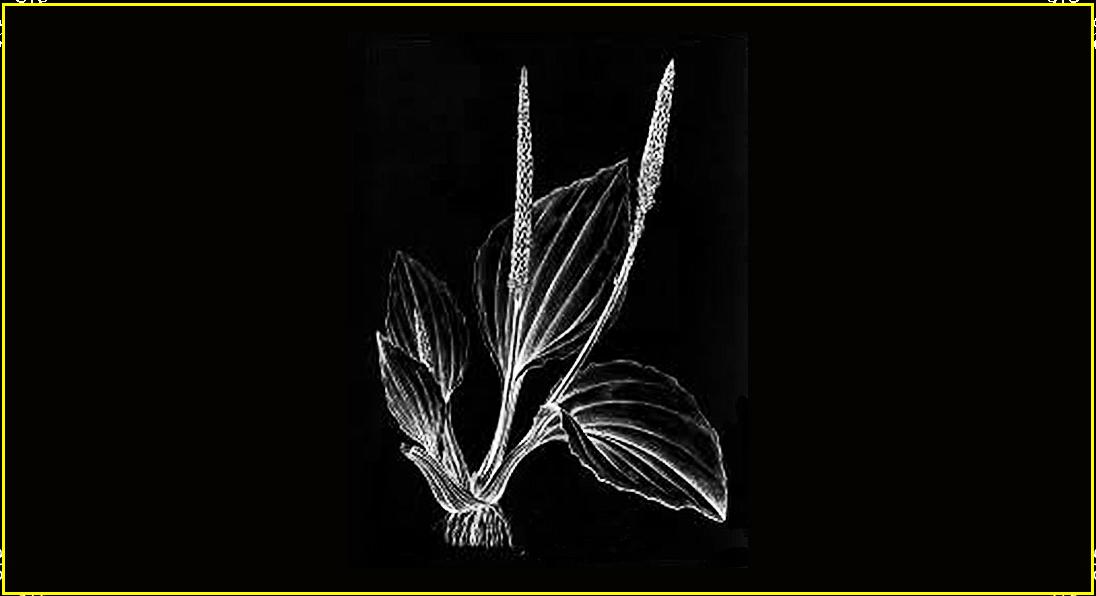Common Plantain is one of the first herbs in which I received instant self healing gratification. A person can simply pick a leave off of the lawn and apply the juice from the crushed leave too an insect bite for instant relieve. Its extract should be of value in veterinary preparations of liniments, paints, washes, salves, poultices--the entire gambit of medications. Horses will graze on plantain and this plant should have many internal applications.
Description: Plantain can grow up to 20" high, Leaves are broad, oval, and ribbed that forms a rosette when growing. Spikes flowers greenish blossoms from May to October.
Location: Waste areas and lawns throughout the USA.
Parts Used: The fresh or dried leave.
Medicinal Uses: This plant has anti-microbial, anti-inflammatory, demulcent, diuretic, astringent properties. The seeds are used as an laxative. The leaves have a long history of being used in poultices by the Indians and Colonists of early America. Leaves were mashed into a paste and applied to wounds, ulcers, and bites. Some value in treating gastric ulcers when taken internally
From AN ADVANCED TREATISE ON HERBS By Dr. Edward E. Shook:
Another incident comes to my mind later on in my life which powerfully illustrates the healing virtues in Herbs. A woman with only one arm came to me in great distress. She had been stung by a bee on the only hand she had left. Several years previously, she had been similarly stung by a bee. That time she had gone to a Doctor because the whole arm was swollen and she was in grave danger.
The Doctor lanced and drained the pus from the infected hand, but still the arm had continued to swell. Ultimately, the arm was amputated. This lady was in abject despair, believing she would lose her other arm.
Outside my door there was some plantain (Plantago Major) growing. I picked some of the leaves and gave them to the woman, telling her to wash and crush them, make a poultice and apply to the part where she had been stung. Next day, this lady returned to thank me and pay for my advice. The hand was entirely well. No sign of poison or inflammation was to be seen, where, but twenty- four hours before there was swelling, inflammation, extreme pain and risk of amputation.
It is of this family of Herbs that the mongoose in India uses to cure his snake bite. A full description of these great and ancient remedies will be given in this course, together with their chemistry and their varied therapeutic applications.
PLANTAIN (Common):
LATIN NAME: Plantago Major. NATURAL
ORDER: Plantaginaceae.
PARTS USED: Root, leaves, flower spikes.
SYNONYMS: Broad-leaved plantain, ripple grass, waybread, snake weed, white man's foot, Englishman's foot, cuckoo's bread.
Traditions are many concerning this Herb. Pliny states it will cure the madness of dogs. Erasmus, in his Colloquia, tells a story of a toad that was bitten by a spider, but was straight away freed from any poisonous effects he may have dreaded, by the prompt eating of a plantain leaf. Another old Herbal says, "If a wood-hound (mad dog) rend a man, take this wort, rub it fine, and lay it on; then will the spot soon be whole." In the United States, this plant is called "snake weed", from the belief in its efficacy in cases of bites of venomous creatures. There is an account of a dog who was stung by a rattlesnake. Promptly, a preparation of the juice of plantain and salt was applied to the wound. The dog, who had been in great agony, quickly recovered, and shook off all traces of his misadventure.
Dr. Robinson (New family Herbal) tells us that an Indian received a great reward from the Assembly of South Carolina for this discovery, and that this plantain was the chief remedy for the cure of the bite of rattlesnakes.
The broad-leaved plantain seems to have followed the migrations of our colonies to every part of the world. Both in America and New Zealand, the Aborigines called it the "Englishman's Foot" (or white man's foot), for wherever the English have taken possession of the soil, the plantain springs up.
Our Saxon ancestors esteemed it highly, in the Old Lacnunga, it is mentioned as one of the nine sacred Herbs. This is one of the oldest and most ancient sources of Anglo-Saxon medicine. Longfellow refers to this wonderful Herb in his famous "Hiawatha." In one of our earlier lessons we told of its curing a woman's badly swollen arm, which was the result of a bee sting.
With such varied and numerous testimony coming from ancient and modern times, there is hardly any room for doubt regarding the virtues of plantain. The following will cover its application:
FORMULA No. 182. Infusion of Plantain.
1 oz. Plantain leaves (cut)
11⁄4 pints distilled water
Boil the water and pour over the herbs. Cover and allow to steep in a hot place for 20 minutes. Strain, add 2 ounces of pure glycerine, cool and bottle. DOSE: 1 wine glassful 3 or 4 times a day.
Children: less, according to age. Locally, for malignant ulcers, especially of the bleeding type, apply on well saturated cotton or thick lint, and cover, changing as often as necessary.
This formula is refrigerant, diuretic, deobstruent, antiseptic, astringent, vulnerary.
We have given you some important keys to the treatment of malignant ulcers and cancers. If you will study them thoroughly and use them intelligently; you will be rewarded with some surprising results.













